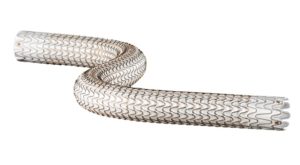
Recently published research indicates that stent grafting with the Viabahn endoprosthesis (W L Gore & Associates) of long and complex superficial femoral artery (SFA) lesions in patients with claudication is a safe and effective long-term treatment option.
Writing in the Journal of Vascular Surgery (JVS), study authors Takao Ohki (The Jikei University School of Medicine, Tokyo, Japan) and colleagues detail that freedom from target lesion revascularisation (fTLR) was 79.1% and that no leg amputations, acute limb ischaemia or stent fractures were observed out to five years in a population of 103 patients.
Once consigned “almost exclusively” to bypass surgery, long and complex SFA lesions can now often be treated successfully with stent grafting, Ohki et al write, noting that primary patency rates are “approaching parity” with surgical bypass outcomes.
In order to assess the long-term safety and efficacy of endovascular stent grafting to treat long, complex SFA lesions with the Viabahn endoprosthesis—a heparin-bonded stent graft—the researchers conducted a prospective, non-randomised, multicentre, single-arm study at 15 Japanese hospitals.
Ohki and colleagues note that patients with Rutherford category 2–5 symptoms (grade 5 without active infection), an ankle brachial index of ≤0.9 and SFA lesions ≥10cm long with ≥50% stenosis were included in the study.
The key efficacy and safety outcomes were primary-assistant patency and adverse events through 24 months, respectively, and the secondary outcomes included primary patency, secondary patency, fTLR and Vascular Quality of Life questionnaire score, the authors communicate.
Ohki et al detail that, of the 103 patients included in the study, the mean age was 74.2±7 years, 82.5% were male and 100 (97.1%) had intermittent claudication. They add that the average lesion length was 21.8±5.8cm and that 87 lesions (84.5%) were TASC (Trans-Atlantic Inter-Society Consensus Document on Management of Peripheral Arterial Disease) C or D (65.7% chronic total occlusions). Of the 103 patients, 92 and 61 were evaluable through 24 and 60 months, respectively.
Ohki and colleagues report in JVS that the Kaplan-Meier-estimated primary-assisted patency, primary patency and secondary patency rate was 85.7% (95% confidence interval [CI], 76.3–91.5%), 78.8% (95% CI, 68.8–85.9%) and 92% (95% CI, 82.4–96.5%) at 24 months, respectively. The mean ankle brachial index was 0.64±0.12 at baseline and 0.94±0.19 at 24 months (p<0.0001).
They also reveal that fTLR was 87.2% (95% CI, 78.9–92.3%) and 79.1% (95% CI, 67.9–86.8%) at 24 and 60 months, respectively. In addition, no device- or procedure-related life- or limb-threatening critical events or acute limb ischaemia cases were observed through five years, and no stent fractures were detected on the annually-scheduled follow-up radiographs.
Furthermore, the authors advise that the vascular quality of life questionnaire and walking impairment questionnaire scores were significantly increased at one through 24 months compared with the baseline scores (p<0.0001 for both), and that one patient had required conversion to open bypass during the five-year follow-up period.













